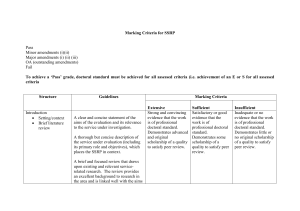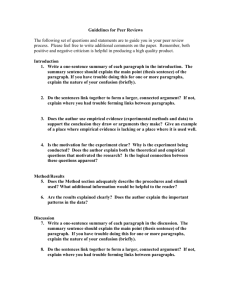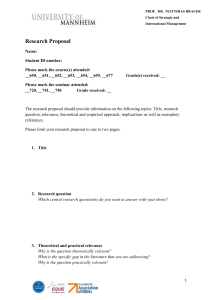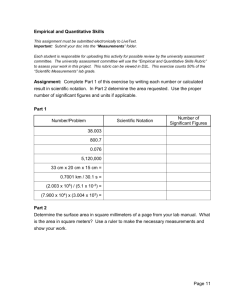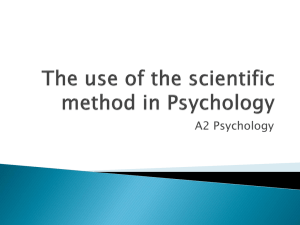Thesis Proposal Marking Guidelines
advertisement
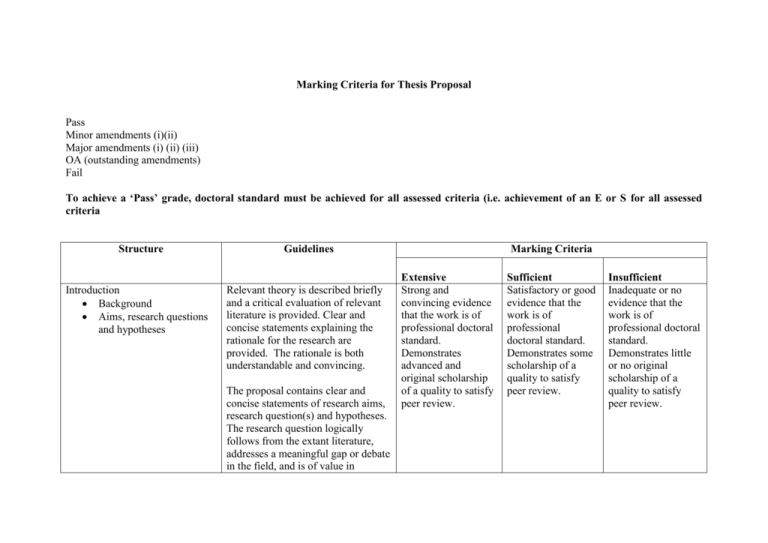
Marking Criteria for Thesis Proposal Pass Minor amendments (i)(ii) Major amendments (i) (ii) (iii) OA (outstanding amendments) Fail To achieve a ‘Pass’ grade, doctoral standard must be achieved for all assessed criteria (i.e. achievement of an E or S for all assessed criteria Structure Introduction Background Aims, research questions and hypotheses Guidelines Relevant theory is described briefly and a critical evaluation of relevant literature is provided. Clear and concise statements explaining the rationale for the research are provided. The rationale is both understandable and convincing. The proposal contains clear and concise statements of research aims, research question(s) and hypotheses. The research question logically follows from the extant literature, addresses a meaningful gap or debate in the field, and is of value in Marking Criteria Extensive Strong and convincing evidence that the work is of professional doctoral standard. Demonstrates advanced and original scholarship of a quality to satisfy peer review. Sufficient Satisfactory or good evidence that the work is of professional doctoral standard. Demonstrates some scholarship of a quality to satisfy peer review. Insufficient Inadequate or no evidence that the work is of professional doctoral standard. Demonstrates little or no original scholarship of a quality to satisfy peer review. answering. Method Literature review Design and method of empirical paper Sample/participants for empirical paper Materials and Procedure for empirical paper Data analysis strategy for empirical paper Ethical considerations for empirical paper The literature review addresses a relevant question. The planned method and procedure for the structured/systematic literature review is clearly presented, in sufficient detail, and appropriate for the question to be addressed. The study design is well described and is clearly appropriate to the research aims. Justification for the methods and measures used is informed by theory and there is a clear rationale for how they will address the research questions. Participants are clearly described and appropriate for the research. Inclusion and exclusion criteria are explicit and there is clear justification for the sample size (including a power analysis where appropriate). The recruitment strategy is understandable, convincing and feasible. If previously collected data are (re)analysed the trainee should demonstrate a substantial contribution within the remit of doctoral level research: i) significant intellectual contribution; (2) an important research study with added value, answering a new research question and generating new knowledge and understanding, beyond the original analysis; (3) trainee acquiring advanced methodological or statistical skills. The measures and materials are appropriate to answer the research question, the study design, and are reliable and valid. The description of the procedure is thorough, logical and coherent, and in sufficient detail to enable replication. All stages involved in conducting the research are clearly described and the approach is feasible. The analysis strategy is clearly described and optimal in addressing the research question(s). There is a thorough justification of the strategy and evidence of in-depth consideration of alternative approaches, where appropriate. Limitations of the approach are considered and addressed. There is a thorough treatment of relevant ethical issues that may arise in the conduct of the research (e.g., risks and inconveniences, recruitment, confidentiality, data protection, informed consent, criteria for participant withdrawal, termination of the research, adequacy of research site). Feasibility & Importance of the Research Timeline for thesis Significance and contribution to knowledge of thesis Cost effectiveness for empirical paper Feasibility of the empirical study The timeframe proposed is entirely appropriate and feasible, taking a thorough account of potential difficulties at each stage of the research. The potential contribution to knowledge is clearly explained and very compelling. The study is good value for money and the costs estimated are appropriate for the planned project. The project is feasible within the given time frame in terms of available expertise from supervisors/field collaborators available, access to patients/study populations is well justified. Estimates of recruitment are reasonable, well-evidenced and not inflated. Dissemination plan of the Plans for dissemination are clearly literature review and empirical described, highly relevant and will paper target the appropriate audiences to ensure the maximum likelihood of the work having an important impact. Quality of the writing and The proposal is extremely well presentation (clarity, coherence written, and develops arguments, and organisation) of thesis ideas and evidence very effectively. proposal The work is written in a logical, sophisticated and sequential manner. BPS Competency Framework (2014) 2.2.1. Generalisable Metacompetencies (including Relationships) = GM 2.2.2. Psychological assessment = PA 2.2.3. Psychological formulation = PF 2.2.4. Psychological intervention = PI 2.2.5. Evaluation = E 2.2.6 Research = R 2.2.7 Personal and professional skills and values = PPSV 2.2.8 Communicating and teaching = CT 2.2.9 Organisational and systemic influence and leadership = OSIL
